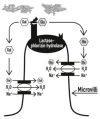Lactose Intolerance: What Your Breath Can Tell You
- PMID: 32560312
- PMCID: PMC7344825
- DOI: 10.3390/diagnostics10060412
Lactose Intolerance: What Your Breath Can Tell You
Abstract
Lactose intolerance has seen recognized as a clinical syndrome characterized by pain, abdominal distention, flatulence, and diarrhea after the consumption of lactose. Lactose is a common disaccharide found in dairy that requires lactase-phlorizin hydrolase (LPH) to break down into glucose and galactose. A deficiency in this enzyme results in flora bacteria further along in the gastrointestinal tract (GI) tract to metabolize the excess lactose to numerous gases, including H2. Recent studies show that the risk of symptoms after lactose ingestion depends on the dose of lactose, LPH expression, intestinal flora, and sensitivity of the gastrointestinal tract. Currently, there are several diagnostic tests that investigate the biological mechanism of lactose intolerance such as blood, biopsy, genetic, and breath tests. Due to its relatively low cost, availability, and non-invasiveness, the hydrogen breath test (HBT) has become a popular technology to aid in the diagnosis of many gastroenterological diseases, specifically lactose intolerance. Additionally, while administering the HBT there seems to be a lack of uniform criteria amongst the various studies, with many using their own guidelines, which may in turn cause inconsistency with the analysis of the results. With ever improving nanotechnology, novel approaches to expedite and lower the costs of the HBT has become an area of research with significant advancements.
Keywords: hydrogen breath test; lactase-phlorizin hydrolase; lactose intolerance; lactose malabsorption; lactose tolerance test.
Conflict of interest statement
The authors declare no conflict of interest. The funders had no role in the design of the study; in the collection, analyses, or interpretation of data; in the writing of the manuscript, or in the decision to publish the results.
Figures




References
-
- Schrimshaw N.S., Murray E.B. Prevalence of Lactose Maldigestion. Am. J. Clin. Nutr. 1988;48:1086–1098.
Publication types
LinkOut - more resources
Full Text Sources

